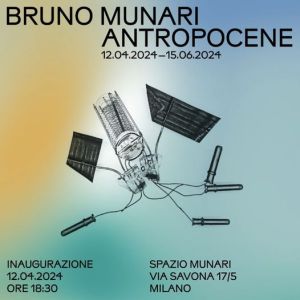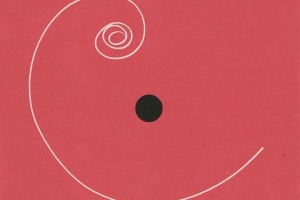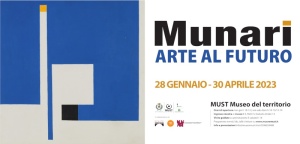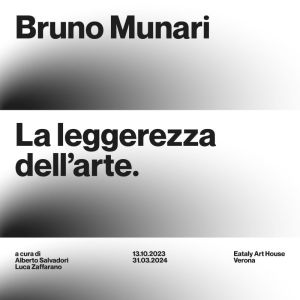417.瀧口修造のムナーリ訪問 ― 2024年07月03日 06:17

ムナーリと親交を結んだ日本人は数多いようですが、とても早い時期にミラノのムナーリを訪問した美術評論家で詩人の瀧口修造の記事が掲載された「美術手帳」(1959年6月号)を手に入れました。
瀧口のムナーリ評は、初対面ながらその特徴を的確に掴んだものだと思います。
瀧口修造 「JOY MAKER BRUNO MUNARI」
幻想空間を創る手品師 ムナーリ
「美術手帳」昭和34(1959)年6月号
Pp.61-71
「ムナーリはミラノに住む芸術家である。私は芸術家と書いたが、かれは画家であり、彫刻家であり、グラフィック・デザイナーであり、インダストリアル・デザイナーでもあって、そしてどれの枠にもはまらない存在だといってよいだろう。日本ではかれのいわゆる「読めない本」のひとつである「暗い夜に」nella notte buiaやデザインなどが雑誌「アイデア」で紹介されたことがあるので、むしろデザインの領域でよく知られている。事実ムナーリは一般にデザイナーだといった方が早わかりのようだが、多くの職業的デザイナーとはゆき方がちがっている。私は昨年のヨーロッパ旅行でデザイナーに会ったり、デザインを勉強するほどの余裕はほとんどなかったが、ミラノでオリヴェッティ会社の専属デザイナーであるピントーリを訪ねたことと、このムナーリの家を訪ねたくらいであった。すべての仕事がいつも新鮮なオリヴェッティ調を創りだすことに捧げられている、いわばすぐれた「現代的な職人」とでもいってよいピントーリにくらべると、ムナーリは自由をたのしんでいる詩人型とでもいえるだろう。かれの活動はいろんな面に分散していて、ちょっとつかみにくい。といって何でも屋の、ディレッタントというのとは別である。ムナーリの仕事にはかれ独特のファンタジーとユーモアがあり、時には底抜けのナンセンスを発揮する。かれのアイデアはたんに人の意表をつくというよりも、人にたのしさをあたえる人間的な暖かさがどの作品にもにじみ出ているのである。実際にその人に会ってしみじみ感じたことである。」
瀧口のムナーリ評は、初対面ながらその特徴を的確に掴んだものだと思います。
瀧口修造 「JOY MAKER BRUNO MUNARI」
幻想空間を創る手品師 ムナーリ
「美術手帳」昭和34(1959)年6月号
Pp.61-71
「ムナーリはミラノに住む芸術家である。私は芸術家と書いたが、かれは画家であり、彫刻家であり、グラフィック・デザイナーであり、インダストリアル・デザイナーでもあって、そしてどれの枠にもはまらない存在だといってよいだろう。日本ではかれのいわゆる「読めない本」のひとつである「暗い夜に」nella notte buiaやデザインなどが雑誌「アイデア」で紹介されたことがあるので、むしろデザインの領域でよく知られている。事実ムナーリは一般にデザイナーだといった方が早わかりのようだが、多くの職業的デザイナーとはゆき方がちがっている。私は昨年のヨーロッパ旅行でデザイナーに会ったり、デザインを勉強するほどの余裕はほとんどなかったが、ミラノでオリヴェッティ会社の専属デザイナーであるピントーリを訪ねたことと、このムナーリの家を訪ねたくらいであった。すべての仕事がいつも新鮮なオリヴェッティ調を創りだすことに捧げられている、いわばすぐれた「現代的な職人」とでもいってよいピントーリにくらべると、ムナーリは自由をたのしんでいる詩人型とでもいえるだろう。かれの活動はいろんな面に分散していて、ちょっとつかみにくい。といって何でも屋の、ディレッタントというのとは別である。ムナーリの仕事にはかれ独特のファンタジーとユーモアがあり、時には底抜けのナンセンスを発揮する。かれのアイデアはたんに人の意表をつくというよりも、人にたのしさをあたえる人間的な暖かさがどの作品にもにじみ出ているのである。実際にその人に会ってしみじみ感じたことである。」
416.ムナーリと葛飾北斎 ― 2024年06月05日 11:23

415で紹介した、パルマ大学の展覧会に関わる1979年のインタビューの中で、ムナーリがクインタヴァッレ教授の質問に対して葛飾北斎と日本の自然観への共感について語っていました。
“Disegnare un albero” è un omaggio ad Hokusai oppure un'indagine sul “naturale”?
「木をかこう」は北斎へのオマージュなのですか?それとも「自然」の探究なのですか?
Tutte e due. Sarebbe bene che anche gli occidentali cominciassero a conoscere gli orientali e ad amare la natura. La differenza sta nel voler dominare la natura (degli occidentali) con quel che ne segue, e il cercar di essere nella natura, degli orientali.
どちらでもあります。西洋人も東洋に学んで自然を愛するようになればいいと私は思います。東洋と西洋の違いは、(西洋の)自然を支配しようとする意識と、東洋の自然の中に自身を置こうとする意識の違いにあります。
407に紹介した「ゼログラフィア」(複写機を使ったインスタレーション)でもムナーリは北斎の作品をモチーフにオマージュを作っているので、クインタヴァッレ教授はムナーリの北斎に対する関心を踏まえて質問を投げかけたのだと思います…。
“Disegnare un albero” è un omaggio ad Hokusai oppure un'indagine sul “naturale”?
「木をかこう」は北斎へのオマージュなのですか?それとも「自然」の探究なのですか?
Tutte e due. Sarebbe bene che anche gli occidentali cominciassero a conoscere gli orientali e ad amare la natura. La differenza sta nel voler dominare la natura (degli occidentali) con quel che ne segue, e il cercar di essere nella natura, degli orientali.
どちらでもあります。西洋人も東洋に学んで自然を愛するようになればいいと私は思います。東洋と西洋の違いは、(西洋の)自然を支配しようとする意識と、東洋の自然の中に自身を置こうとする意識の違いにあります。
407に紹介した「ゼログラフィア」(複写機を使ったインスタレーション)でもムナーリは北斎の作品をモチーフにオマージュを作っているので、クインタヴァッレ教授はムナーリの北斎に対する関心を踏まえて質問を投げかけたのだと思います…。
412.ムナーリ作品集の復刻 ― 2024年05月05日 05:07

イタリアではムナーリの研究者メネグッツォの監修による過去最大の回顧展が開かれているそうですが、これに合わせるように、ムナーリ研究者として名高いもう一人の人物アルド・タンキスによるムナーリの作品集がコライーニ社から復刻されたとのニュースが届きました。
タンキスの編んだ作品集もムナーリ生前の編集で本人に直接取材してまとめられた内容が含まれる貴重なものですが、復刻にあたあって更に改訂も加えられているとか。イタリア語版の他に英語版もあるようです。
定価が48ユーロ弱とのこと、1ユーロ165円の円安状態でも約7000円と比較的お手頃ですが、いまのところ日本のamazonでは取り扱いがないようです(あっても送料などが上乗せになると思いますが…)
コライーニ社ならウェブを通じて直接通販購入ができるかもしれません(英語の対応があると思います)。
タンキスの編んだ作品集もムナーリ生前の編集で本人に直接取材してまとめられた内容が含まれる貴重なものですが、復刻にあたあって更に改訂も加えられているとか。イタリア語版の他に英語版もあるようです。
定価が48ユーロ弱とのこと、1ユーロ165円の円安状態でも約7000円と比較的お手頃ですが、いまのところ日本のamazonでは取り扱いがないようです(あっても送料などが上乗せになると思いますが…)
コライーニ社ならウェブを通じて直接通販購入ができるかもしれません(英語の対応があると思います)。
411.ムナーリの人新世(20世紀の化石) ― 2024年04月14日 19:49

ミラノの「スパツィオ・ムナーリ」ではムナーリの新しい企画展がはじまったそうです(MUNARIAのミケーラさんが教えてくれました)。
ムナーリが1950-60年代に発表したアート作品「二十世紀の化石(Fossili del 2000)」を中心にした展示で、展覧会の題名「BRUNO MUNARI ANTROPOCENE」とは「ムナーリの人新世」という意味になります。
ウィキによれば「人新世とは、人類が地球の地質や生態系に与えた影響に注目して提案されている地質時代における現代を含む区分である。人新世の特徴は、地球温暖化などの気候変動、大量絶滅による生物多様性の喪失、人工物質の増大、化石燃料の燃焼や核実験による堆積物の変化などがあり、人類の活動が原因とされる。」と説明されています。
作品は電子部品などの部品がアクリルブロックの中に封入されたもので、現代社会が生み出す「ゴミ」が未来の化石になるだろう…というムナーリの皮肉が込められているようです。
展覧会場の解説パネルの一部内容を、ざっくりと紹介してみます。
Non ci si pensa mai, tanto siamo ossessionati dal presente, ma già ora, qui, noi siamo materia in fieri per gli archeologi del futuro. Siamo un primate africano di grossa taglia comparso sul pianeta Terra solo duecento millenni fa, Sono passate soltanto 8000 generazioni, 8000 passaggi di madre in figlio, da quando i primi pionieri della specie "Homo sapiens" cominciarono a migrare nel mondo, Eppure, abbiamo già lasciato tracce che rimarranno per milioni di anni, Siamo i fossili di domani.
今ここでさえ、私たちは未来の考古学者にとって重要な存在なのだ。 私たち、つまりわずか200万年前に地球上に出現したアフリカの大型霊長類「ホモ・サピエンス」という種の最初のパイオニアが世界中を移動し始めてからわずか8000世代、8000の親子の交代しか経ていないが、私たちはすでに何百万年も残る痕跡を残している、私たちは未来の化石なのだ。
Negli strati geologici dell'Antropocene, gli studiosi di un futuro remoto dissotterreranno una poltiglia indifferenziata di plastiche e transistor, micro-chip, valvole radio, bulloni e lattine, ceramiche e bronzi, acciai, vetri, asfalti e cementi, gas serra, isotopi radioattivi, cattedrali e grandi muraglie, montagne di ossa di polli, ovini, suini e bovini, Oggi poi, mentre l'orologio dell'apocalisse sfiora pericolosamente la sua Ora X, stiamo alacremente lavorando alla nostra auto-candidatura come soggetti di un'archeologia post-umana. 遠い未来の学者たちが、人新世の地層からプラスチックやトランジスタ、マイクロチップ、無線バルブ、ボルトやブリキ缶、セラミックやブロンズ、鋼鉄、ガラス、アスファルトやセメント、温室効果ガス、放射性同位元素など、未分化のドロドロしたものを発掘するだろう、 黙示録の時計が危険なX時刻に近づいている今日、私たちはポスト・ヒューマン考古学の対象として自分たちの候補者探しに奔走しているようだ。 Ma non sarà facile finire in un Museo alieno. Ammirando questi geniali e visionari reperti artistici combinatori di Bruno Munari, vien da pensare a quanta fortuna ci vuole per diventare campioni per archeologi. Non basta il metacrilato, La tecnologia invecchia presto e il futuro di questi oggetti immaginati nel 1959, ovvero l'anno 2000, per noi è già un passato vintage.
しかし宇宙人たちの博物館にたどり着くのは容易なことではない。ブルーノ・ムナーリの独創的で先見の明のある芸術的な組み合わせの人工物を眺めていると、考古学者のチャンピオンになるにはどれほどの幸運が必要なのだろう?と思わせられる。メタクリル酸塩だけでは不十分で、技術はすぐに古くなり、1959年に想像されたこれらのオブジェの未来だった2000年は私たちにとってはすでに骨董品の過去だ。
Sul lungo periodo, solo una combinazione altamente improbabile di fattori di conservazione e sedimentazione permetterà a un artefatto umano o a un nostro ossicino di essere studiato dai paleontologi del futuro lontano.
長い目で見れば、遠い未来の古生物学者が人間の遺物や小さな骨を研究できるようになるのは、保存と堆積の要因の極めてありえない組み合わせだけだ。
Sarà davvero un privilegio, perché poi quelle menti postume si interrogheranno costruttivamente su ciò che circonda quel fossile, sul suo enigmatico significato, sulla sua origine incerta e l'uso ignoto, Soprattutto, proporranno ricostruzioni teoriche su ciò che non lascia tracce: le parole e i pensieri di popoli sconosciuti. Proprio come succede quando ciascuno di noi, liberamente, riempie di senso una scrittura illeggibile o un collage di Munari, rendendoli opera collettiva.
それは実に特権的なことだろう。なぜなら遺された未来の人々は、その化石を取り巻くものやその謎めいた意味、不確かな起源、未知の用途について建設的な疑問を投げかけ、とりわけ痕跡を残さないもの:未知の民族の言葉(※ムナーリの別の作品タイトル)や思考について理論的な再構築を提案するからだ。私たち一人一人が読みにくい手書き文字やムナーリのコラージュに自由に意味を込めてコレクティブな作品にするのと同じように。 Noi infatti abbiamo immaginazione e fantasia, quelle che mancano ai virus e agli asteroidi, Facciamo esistere quel che prima non c'era e possiamo sceglierci un futuro diverso. Il meglio che possiamo fare dunque, in mezzo a tutta questa evanescente incertezza e alla finitudine che ci accomuna, è salvarci mantenendo vivo il Museo immaginario di Munari stesso, archeologia gioiosa della creatività di "Homo sapiens"!
私たちは、ウイルスや小惑星がもっていない想像力とファンタジーをもっていて、 以前には存在しなかったものを存在させ自分たちのために異なる未来を選択することができる。この儚い不確実性と私たちを結びつける有限性の中で、私たちにできる最善のことはムナーリ自身のイマジナリーミュージアムを存続させ、「ホモ・サピエンス」の創造性を楽しく考古学することによって私たち自身を救うことなのだ!
Telmo Pievani, 2024
(テルモ・ピエヴァーニ:イタリアの若手哲学者)
ムナーリが1950-60年代に発表したアート作品「二十世紀の化石(Fossili del 2000)」を中心にした展示で、展覧会の題名「BRUNO MUNARI ANTROPOCENE」とは「ムナーリの人新世」という意味になります。
ウィキによれば「人新世とは、人類が地球の地質や生態系に与えた影響に注目して提案されている地質時代における現代を含む区分である。人新世の特徴は、地球温暖化などの気候変動、大量絶滅による生物多様性の喪失、人工物質の増大、化石燃料の燃焼や核実験による堆積物の変化などがあり、人類の活動が原因とされる。」と説明されています。
作品は電子部品などの部品がアクリルブロックの中に封入されたもので、現代社会が生み出す「ゴミ」が未来の化石になるだろう…というムナーリの皮肉が込められているようです。
展覧会場の解説パネルの一部内容を、ざっくりと紹介してみます。
Non ci si pensa mai, tanto siamo ossessionati dal presente, ma già ora, qui, noi siamo materia in fieri per gli archeologi del futuro. Siamo un primate africano di grossa taglia comparso sul pianeta Terra solo duecento millenni fa, Sono passate soltanto 8000 generazioni, 8000 passaggi di madre in figlio, da quando i primi pionieri della specie "Homo sapiens" cominciarono a migrare nel mondo, Eppure, abbiamo già lasciato tracce che rimarranno per milioni di anni, Siamo i fossili di domani.
今ここでさえ、私たちは未来の考古学者にとって重要な存在なのだ。 私たち、つまりわずか200万年前に地球上に出現したアフリカの大型霊長類「ホモ・サピエンス」という種の最初のパイオニアが世界中を移動し始めてからわずか8000世代、8000の親子の交代しか経ていないが、私たちはすでに何百万年も残る痕跡を残している、私たちは未来の化石なのだ。
Negli strati geologici dell'Antropocene, gli studiosi di un futuro remoto dissotterreranno una poltiglia indifferenziata di plastiche e transistor, micro-chip, valvole radio, bulloni e lattine, ceramiche e bronzi, acciai, vetri, asfalti e cementi, gas serra, isotopi radioattivi, cattedrali e grandi muraglie, montagne di ossa di polli, ovini, suini e bovini, Oggi poi, mentre l'orologio dell'apocalisse sfiora pericolosamente la sua Ora X, stiamo alacremente lavorando alla nostra auto-candidatura come soggetti di un'archeologia post-umana. 遠い未来の学者たちが、人新世の地層からプラスチックやトランジスタ、マイクロチップ、無線バルブ、ボルトやブリキ缶、セラミックやブロンズ、鋼鉄、ガラス、アスファルトやセメント、温室効果ガス、放射性同位元素など、未分化のドロドロしたものを発掘するだろう、 黙示録の時計が危険なX時刻に近づいている今日、私たちはポスト・ヒューマン考古学の対象として自分たちの候補者探しに奔走しているようだ。 Ma non sarà facile finire in un Museo alieno. Ammirando questi geniali e visionari reperti artistici combinatori di Bruno Munari, vien da pensare a quanta fortuna ci vuole per diventare campioni per archeologi. Non basta il metacrilato, La tecnologia invecchia presto e il futuro di questi oggetti immaginati nel 1959, ovvero l'anno 2000, per noi è già un passato vintage.
しかし宇宙人たちの博物館にたどり着くのは容易なことではない。ブルーノ・ムナーリの独創的で先見の明のある芸術的な組み合わせの人工物を眺めていると、考古学者のチャンピオンになるにはどれほどの幸運が必要なのだろう?と思わせられる。メタクリル酸塩だけでは不十分で、技術はすぐに古くなり、1959年に想像されたこれらのオブジェの未来だった2000年は私たちにとってはすでに骨董品の過去だ。
Sul lungo periodo, solo una combinazione altamente improbabile di fattori di conservazione e sedimentazione permetterà a un artefatto umano o a un nostro ossicino di essere studiato dai paleontologi del futuro lontano.
長い目で見れば、遠い未来の古生物学者が人間の遺物や小さな骨を研究できるようになるのは、保存と堆積の要因の極めてありえない組み合わせだけだ。
Sarà davvero un privilegio, perché poi quelle menti postume si interrogheranno costruttivamente su ciò che circonda quel fossile, sul suo enigmatico significato, sulla sua origine incerta e l'uso ignoto, Soprattutto, proporranno ricostruzioni teoriche su ciò che non lascia tracce: le parole e i pensieri di popoli sconosciuti. Proprio come succede quando ciascuno di noi, liberamente, riempie di senso una scrittura illeggibile o un collage di Munari, rendendoli opera collettiva.
それは実に特権的なことだろう。なぜなら遺された未来の人々は、その化石を取り巻くものやその謎めいた意味、不確かな起源、未知の用途について建設的な疑問を投げかけ、とりわけ痕跡を残さないもの:未知の民族の言葉(※ムナーリの別の作品タイトル)や思考について理論的な再構築を提案するからだ。私たち一人一人が読みにくい手書き文字やムナーリのコラージュに自由に意味を込めてコレクティブな作品にするのと同じように。 Noi infatti abbiamo immaginazione e fantasia, quelle che mancano ai virus e agli asteroidi, Facciamo esistere quel che prima non c'era e possiamo sceglierci un futuro diverso. Il meglio che possiamo fare dunque, in mezzo a tutta questa evanescente incertezza e alla finitudine che ci accomuna, è salvarci mantenendo vivo il Museo immaginario di Munari stesso, archeologia gioiosa della creatività di "Homo sapiens"!
私たちは、ウイルスや小惑星がもっていない想像力とファンタジーをもっていて、 以前には存在しなかったものを存在させ自分たちのために異なる未来を選択することができる。この儚い不確実性と私たちを結びつける有限性の中で、私たちにできる最善のことはムナーリ自身のイマジナリーミュージアムを存続させ、「ホモ・サピエンス」の創造性を楽しく考古学することによって私たち自身を救うことなのだ!
Telmo Pievani, 2024
(テルモ・ピエヴァーニ:イタリアの若手哲学者)
407.ムナーリと葛飾北斎 ― 2024年03月21日 20:15

2024年3月に北米のオークションハウスで葛飾北斎の「富嶽三十六景」一式(全46図)が355万9千ドル(約5億3700万円)で落札されたという話題がニュースから流れてきました。
ミラノの「スパツィオ・ムナーリ」では2024年2月にムナーリの複写機を使った作品「ゼログラフィア」が展示されていたのですが、その中にも北斎の作品に対するオマージュがあったことを思い出しました。ギャラリーの壁で複写機によって大胆にゆがめられた北斎の「波」の横には、ムナーリの言葉が記されていました。
Ho invitato l'amico e collega
Katsuita Hokusai a giocare con me
dando spinte elettrostatiche alla sua famosissima onda
per accompagnare con movimenti e suoni questa straordinaria produzione del mare che presento in questo libretto.
Hokusai non era soltanto un pittore aveva curiosità leonardesche si interessava di architetture di machine strane di costumi si divertiva a fare strabilianti caricature (io l'ho conosciuto quando lui era già andato a curiosare nell'altro mondo).
Grazie caro amico, grazie del tuo insegnamento allegro.
Bruno Munari, Il mare come artigiano,
Corraini Edizioni, 1995
私は友人であり同僚でもある
葛飾北斎を遊びに誘った(パネルでは綴りが「カツイタ」になっていましたが…)
かの有名な波に電磁の一押しを加えながら
この小さな本で紹介する彼の海の驚異的な演出に、動きと音を添えるために。
北斎は画家であるだけでなく、レオナルド(ダ・ヴィンチ)のように建築や奇妙な機械や衣装に興味をもち、驚くべき風刺画を描いて楽しんだ(私が彼を知ったのは、彼がすでにあの世を探索しに行ったあとだ)。
ありがとう我が友、君の陽気な教えに感謝している。
ミラノの「スパツィオ・ムナーリ」では2024年2月にムナーリの複写機を使った作品「ゼログラフィア」が展示されていたのですが、その中にも北斎の作品に対するオマージュがあったことを思い出しました。ギャラリーの壁で複写機によって大胆にゆがめられた北斎の「波」の横には、ムナーリの言葉が記されていました。
Ho invitato l'amico e collega
Katsuita Hokusai a giocare con me
dando spinte elettrostatiche alla sua famosissima onda
per accompagnare con movimenti e suoni questa straordinaria produzione del mare che presento in questo libretto.
Hokusai non era soltanto un pittore aveva curiosità leonardesche si interessava di architetture di machine strane di costumi si divertiva a fare strabilianti caricature (io l'ho conosciuto quando lui era già andato a curiosare nell'altro mondo).
Grazie caro amico, grazie del tuo insegnamento allegro.
Bruno Munari, Il mare come artigiano,
Corraini Edizioni, 1995
私は友人であり同僚でもある
葛飾北斎を遊びに誘った(パネルでは綴りが「カツイタ」になっていましたが…)
かの有名な波に電磁の一押しを加えながら
この小さな本で紹介する彼の海の驚異的な演出に、動きと音を添えるために。
北斎は画家であるだけでなく、レオナルド(ダ・ヴィンチ)のように建築や奇妙な機械や衣装に興味をもち、驚くべき風刺画を描いて楽しんだ(私が彼を知ったのは、彼がすでにあの世を探索しに行ったあとだ)。
ありがとう我が友、君の陽気な教えに感謝している。
396.パルマの僧院で ― 2024年02月22日 21:05

一つ前のトピックで紹介したイタリア・パルマの展覧会を、イタリアで会った方々のご厚意で見ることができました。
厳密にはムナーリ個人の展覧会ではなく、パルマ大学視覚伝達研究センター(CSAC)のアーカイブ・コレクションを元にした20世紀のアートとファッション、デザインなど領域をまたいだ企画展でした。その中にムナーリの作品も複数展示されていた、ということです。
ムナーリは自身のデザインワークに関する資料の多くをCSACに寄贈していたようです。
会場はパルマの市街からかなり離れた郊外にぽつんとたたずむ古い大きな教会跡で、説明によるとスタンダールの小説『パルムの僧院』とも関係があるとか。
厳密にはムナーリ個人の展覧会ではなく、パルマ大学視覚伝達研究センター(CSAC)のアーカイブ・コレクションを元にした20世紀のアートとファッション、デザインなど領域をまたいだ企画展でした。その中にムナーリの作品も複数展示されていた、ということです。
ムナーリは自身のデザインワークに関する資料の多くをCSACに寄贈していたようです。
会場はパルマの市街からかなり離れた郊外にぽつんとたたずむ古い大きな教会跡で、説明によるとスタンダールの小説『パルムの僧院』とも関係があるとか。
395.ムナーリの展覧会(2024パルマ) ― 2024年01月27日 23:30

先日はイタリアのムナーリ展情報を見つけた!とぬか喜び(2023年の展覧会でした)をしてしまいましたが、あらためて調べてみると2024年1月20日からパルマ大学のコミュニケーション研究センター(CSAC)で、「(不)可能なビジョン。(Visioni (im)possibili.)」と題した展覧会が開催されるようです。
パルマ大学のコミュニケーション研究センターはムナーリのビジュアルコミュニケーションに関する豊富なコレクションを所蔵して、カタログも出版されていたはずです。
近いうちにイタリアまで調査出張を予定しているので、できれば足を運んでみたいと思っています…。
“Visioni (im)possibili. Comunicazione, utopia, progetto nelle collezioni CSAC
パルマ大学のコミュニケーション研究センターはムナーリのビジュアルコミュニケーションに関する豊富なコレクションを所蔵して、カタログも出版されていたはずです。
近いうちにイタリアまで調査出張を予定しているので、できれば足を運んでみたいと思っています…。
“Visioni (im)possibili. Comunicazione, utopia, progetto nelle collezioni CSAC
394. ムナーリの展覧会(2023) ― 2024年01月02日 22:02

イタリアではムナーリの展覧会が開催されるという記事が紹介されていました。
ヴィメルカーテという、ミラノからあまり遠くない町のMUSTという美術館だそうです。
…記事を見つけたのが新年だったので2024かと勘違いしていましたが残念、2023年1月から4月とのこと、すでに終了していました…
Mostra Munari a Vimercate, 2023
https://www.museomust.it/munari/
ヴィメルカーテという、ミラノからあまり遠くない町のMUSTという美術館だそうです。
…記事を見つけたのが新年だったので2024かと勘違いしていましたが残念、2023年1月から4月とのこと、すでに終了していました…
Mostra Munari a Vimercate, 2023
https://www.museomust.it/munari/
388.「芸術の軽やかさ」(展覧会) ― 2023年10月13日 05:26

ヴェローナという、北イタリアのミラノとヴェネチアの中間あたりにある街でムナーリの展覧会がはじまったそうです(ヴェローナはシェイクスピアの「ロメオとジュリエット」の舞台にもなっている、古代ローマ起源の美しい街です)。
「芸術の軽やかさ(La leggerezza dell'arte)」というタイトルがついているので、ムナーリのアートワークを中心にしたものでしょう。同じ時期にヴェローナの見本市会場ではアートフェア(アート作品の見本市)があるようです。
展覧会会場のギャラリーが「Eataly Art House Verona」とあるので、日本でも展開しているイタリア食材のブランディング「Eataly」と関係があるのかもしれません。
2023年10月13日から2024年3月末までの展示だそうです。
「芸術の軽やかさ(La leggerezza dell'arte)」というタイトルがついているので、ムナーリのアートワークを中心にしたものでしょう。同じ時期にヴェローナの見本市会場ではアートフェア(アート作品の見本市)があるようです。
展覧会会場のギャラリーが「Eataly Art House Verona」とあるので、日本でも展開しているイタリア食材のブランディング「Eataly」と関係があるのかもしれません。
2023年10月13日から2024年3月末までの展示だそうです。
387.ミラノの「スパツィオ・ムナーリ」 ― 2023年10月09日 22:43

しばらく前、ミラノに新たなムナーリに関するスペースができる、というニュースがSNSから流れてきましたが、プレリリースの通りにミラノにあるコライーニ社のテンポラリー・ブックショップ(以前からミラノ・サローネなどイベントの期間にオープンしていたお店)の空間が、「スパツィオ・ムナーリ(ムナーリの空間)」と名付けられてリニューアルしたようです。
イタリアのアートニュースの記事によると、オープン記念の展覧会「小さな家族的なものたち」という、ムナーリのお孫さんたちのコレクションを中心とした展示がおこなわれているとのこと。
アートニュースの記事に添えられた「スパツィオ・ムナーリ」の写真を見ると、本棚には少なくとも三冊の日本で出版されているムナーリの作品集が並べられています…
イタリアのアートニュースの記事によると、オープン記念の展覧会「小さな家族的なものたち」という、ムナーリのお孫さんたちのコレクションを中心とした展示がおこなわれているとのこと。
アートニュースの記事に添えられた「スパツィオ・ムナーリ」の写真を見ると、本棚には少なくとも三冊の日本で出版されているムナーリの作品集が並べられています…
最近のコメント